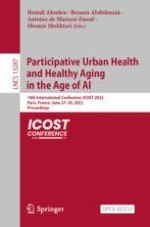Trip planning tools were developed to help people reach their destinations through different modes of transport (e.g., car, taxi, bus, car sharing, bicycle, walking), give them details about the trip (e.g., directions, which bus to take, which station) and provide users the option of planning their trips whenever they want. Based on our analysis, most of the existing tools address the shortest/fastest path functionalities considering only one criterion (i.e., distance, time, or number of transfers), which make them not tailored to older adults’ needs and preferences, except for a set of tools that provide some options and functionalities that might be useful for older adults. A few number of tools address the walkability either by minimizing walking (transit
1, moovit
2), or by considering the maximal tolerated walking distance and speed of the walk (Mobilitéit
3, alternéo
4). The prototype mPASS [
5] customizes maps and paths to each user’s needs and preferences, based on the user’s profile and location. mPASS [
5] provides users with accessible paths taking into consideration accessibility barriers and facilities like stairs and zebra crossing. Path2.0 [
6] suggests accessible paths to users with disabilities by providing users with the shortest/fastest path as well as the path that was frequently utilized by other users with the same disabilities.
Transit (See footnote 1) is a mobile application proposing paths without stairs and avoiding slopes; while ViaNavigo
5, RATP
6 and Google maps
7 suggest accessible paths for people with reduced mobility using a wheelchair. Furthermore, few tools give information about the crowd, in other words, road traffic (Google maps (See footnote 7)) and bus crowd (Google maps (See footnote 7) and RATP (See footnote 6)) that remains to be a useful information especially for older adults who want to avoid crowded places and roads. In the aim of encouraging active and ecofriendly paths, Citymapper
8 calculates respectively the burned calories and the amount of CO
2 emission. Additionally, information about weather was given by Mobilitéit (See footnote 3), OC transpo
9. To conclude, the presented trip planning tools don’t consider the totality of older adults’ needs and preferences. Therefore, there is a need for an approach that takes the diversity of older adult needs in consideration for building the trip planner, which was the first motivation behind our Mobilaînés project.
